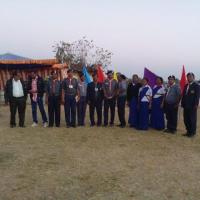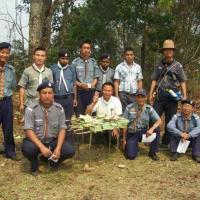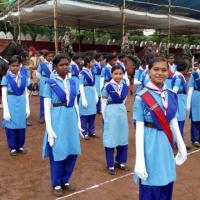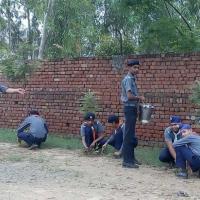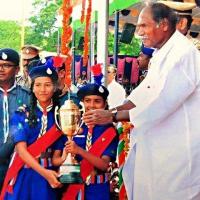
The Bharat Scouts & Guides, India, Scouts/Guides/Rovers/Rangers are celebrate 69th Independent Day on 15.08.2015
Independence Day in India
India celebrates Independence Day on August 15 each year. India became an independent nation on August 15, 1947, so a gazetted holiday is held annually to remember this date.
What do people do?
Independence Day is a day when people in India pay homage to their leaders and those who fought for India's freedom in the past. The period leading up to Independence Day is a time when major government buildings are illuminated with strings of lights and the tricolor flutters from homes and other buildings. Broadcast, print and online media may have special contests, programs, and articles to promote the day. Movies about India's freedom fighters are also shown on television.
The president delivers the '"Address to the Nation" on the eve of Independence Day. India's prime minister unfurls India's flag and holds a speech at the Red Fort in Old Dehli. Flag hoisting ceremonies and cultural programs are held in the state capitals and often involve many schools and organizations.
Many people spend the day with family members or close friends. They may eat a picnic in a park or private garden, go to a film or eat lunch or dinner at home or in a restaurant. Other people go kite flying or sing or listen to patriotic songs.
Public life
Independence Day is a gazetted holiday in India on August 15 each year. National, state and local government offices, post offices and banks are closed on this day. Stores and other businesses and organizations may be closed or have reduced opening hours.
Public transport is usually unaffected as many locals travel for celebrations but there may be heavy traffic and increased security in areas where there are celebrations. Independence Day flag raising ceremonies may cause some disruption to traffic, particularly in Dehli and capital cities in India's states.
Background
The struggle for India's Independence began in 1857 with the Sepoy Mutiny in Meerut. Later, in the 20th century, the Indian National Congress and other political organizations, under the leadership of Mahatma Gandhi, launched a countrywide independence movement. Colonial powers were transferred to India on August 15, 1947.
The Constituent Assembly, to who power was to be transferred, met to celebrate India's independence at 11pm on August 14, 1947. India gained its liberty and became a free country at midnight between August 14 and August 15, 1947. It was then that the free India's first prime minister Pandit Jawaharlal Nehru gave his famous "Tryst with Destiny" speech. People across India are reminded of the meaning of this event - that it marked the start of a new era of deliverance from the British colonialism that took place in India for more than 200 years.
Symbols
The sport of kite flying symbolizes Independence Day. The skies are dotted with countless kites flown from rooftops and fields to symbolize India's free spirit of India. Kites of various styles, sizes and shades, including the tricolor are available in the marketplaces. The Red Fort in Dehli is also an important Independence Day symbol in India as it is where Indian Prime Minister Jawahar Lal Nehru unveiled India's flag on August 15, 1947.
India's national flag is a horizontal tricolor of deep saffron (kesaria) at the top, white in the middle and dark green at the bottom in equal proportion. The ratio of the flag's width to its length is two to three. A navy-blue wheel in the center of the white band represents the chakra. Its design is that of the wheel which appears on the abacus of the Sarnath Lion Capital of Ashoka. Its diameter approximates to the white band's width and it has 24 spokes.
History of Indian Independence Day
The history behind Indian independence is very painful and is full of sacrifices. And only because of those sacrifices India freed herself from the shackles of British Empire on 15th August 1947. It was an endless struggle of millions faceless Indians, who made the inhabitants united and fought for the freedom of their own country.
The year 1857 is a benchmark in the history of Indian independence. On 29th march 1875, a brave Indian soldier first ever raised his voice against the British Empire and later it resulted to Sepoy Mutiny.
The name of the Indian soldier was Mangal Pandey, and the reason behind his revolt was, low wages of Indian workers than other British soldiers, racial discrimination and cultural misunderstandings. And another strong reason was the packing of the cartridges which was believed to be greased with cow and pig fat and soldiers had to tear the packing with their teeth in order to use it. And that was something which considered being very unholy for the hindu soldiers. Combination of all these issues led to the violent uprising of Barrakpore Sepoy mutiny. Mangal Pandey, the Hindu soldier of the 34th Native infantry was hanged as because he had shot his sergeant major on the parade ground. This incident fanned the fire of the revolution. On 10th may of the same year the enraged Indian soldiers and the common civilians of Meerut joined their hands to protest against the ill-treatment of the British on some native soldiers. Later this revolt took a big form but it was eventually put down by the effective British military.
In next few decades there were many small and big wars fought against the empire. Among these wars most prominent were the Battle of Kanpur led by Nana Shahib of Bittur, the Battle of Jhansi led by the Queen of Jhansi Rani Laxmibai and Tantia Tope, the fight of Arrah in Bihar led Kunwar Singh the landlord of Jagdishpur and the war at Lucknow led by Hazrat Begum. These battles were the indications of the discontent of the Indians against their European rulers.
In 20th century, the dissatisfaction towards the British Government began to take a concrete shape.
In the beginning of 1900 there were several revolutionary groups sprang up in different parts of the country such as Bengal, Punjab, Gujrat, Assam and the southern states of India. Several extremist organizations with arms started to sprang up with one aim that is to earn freedom through violent activities. This discontentment for freedom was not without reason. The British Government never treated the Indian natives with the deserving respect. They are always considered as low-lives comparing to the British counterparts. They don’t treat them with leniency even for the small crimes while the British civilians were being let off, even if they were found guilty of committing murders. In every path of their lives the Indians found themselves deprived. Some political groups such as Congress were formed to convey the voices of millions anguished natives to the British Empire in a peaceful manner. Some of the iconic leaders like Mahatma Gandhi, Subhash Chandra Bose, Jawaharlal Nehru and Lala Lajpat Rai , had tried to attain freedom through peaceful means. On the other hand personalities like Mastarda Surya Sen, Chandrasekhar Azad, Bhagat Singh, had taken extreme measure to snatch freedom from the British Empire.
In 1930 Mahatma Gandhi started the famous “Salt March” and after that in 1942 he started the “Quit India Movement”. The amount of public support and remonstration was more than before. All those things which were Western were burnt or thrown away. Purna Swaraj or total freedom was demanded from the British Government. In answer to this protest the British Government imprisoned thousands of Congress leaders and civilians along with Gandhi. Subhash Chandra Bose, who idealisms were extremist, got drifted from Congress and formed a new party named the All India Forward Block Party and launched his own army named Indian National Army (INA). And by this military might he tried to attain freedom from the clutches of the British Empire. Initially they were successful. But with the sudden demise of Netaji (as Subhash Chandra Bose was popularly known to his countrymen) the entire nation saw the evanescent of the INA.
Later with two successive world wars, the resources of the British Empire were eventually drained to a certain extent that they found it really very difficult to manage India. And on top of that the huge discontent of the native Indians who wanted British to leave their country at any cost was driving them crazy. Non violent protests as well as extremist activities were being carried out on the daily basis. On this scenario the British was clear about one thing that their reign over this country were going to be over soon.
At last the day came, in the year 1947, June 3rd Viscount Louis Mountbatten, the last British Governor-General of India, declared that the British will leave the Indian subcontinent. But before leaving India they had decided to split up their Indian British Empire into secular India and Muslim Pakistan. This was done because the Muslims in India felt that their demands were not thoroughly represented by the Congress. And after the desired freedom they would not have equal opportunities as the Congress. They thought that after independence the Congress would give preference to the Hindus and therefore this thought lead to the demand for a separate nation. Pakistan was officially announced as an independent nation on 14th August 1947. And at midnight, on 15th August 1947, India was declared to be an independent nation by her first Prime Minister Pandit Jawaharlal Nehru.
The Bharat Scouts & Guides, India, Scouts/Guides/Rovers/Rangers are
celebrate 69th Independent Day on 15.08.2015
69th Independent Day on 15.08.2015 The Bharat Scouts & Guides, India ,Scouts/Guides/Rover/Rangers & Unit Leaders/ Professionals are actively Participate for Celebreating 69th Indpendence Day in India. More over more than 02 laks Scouts/Guides/Rover/Rangers & Unit Leaders/ Professionals are participating the above celebreation all over country. For this celebreation all the Scouts/Guides/Rover/Rangers & Unit Leaders/ Professionals started work on 07.08.2015 . This Ten days some pleaces they did Plantation, Investure ceremony, public awareness, Clenness, adult education, peace march, Stop global warming, Actively participate in Parade etc. Each of day our Scouts/Guides/Rover/Rangers & Unit Leaders/ Professionals spend 04 hourse for success of this celebreation.
I am proud to publish the report of Messenger of Peace team how our Scouts/Guides/Rover/Rangers & Unit Leaders/ Professionals are celebrating 69th Independence day a Grand success.
Ashok Kumar Mohapatra
Assist Director, NER










